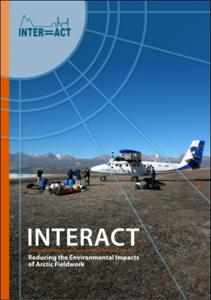| dc.contributor.author | Frendrup, Laura Lønstrup | |
| dc.contributor.author | Rasch, Morten | |
| dc.contributor.author | Topp-Jørgensen, Elmer | |
| dc.contributor.author | Arndal, Marie Frost | |
| dc.coverage.spatial | Arctic Region | en_US |
| dc.date.accessioned | 2022-01-17T18:31:53Z | |
| dc.date.available | 2022-01-17T18:31:53Z | |
| dc.date.issued | 2021 | |
| dc.identifier.citation | INTERACT (2021) INTERACT Reducing the Environmental
Impacts of Arctic Fieldwork [by Frendrup, Laura Lønstrup, Rasch, Morten, Topp-Jørgensen, Elmer
Arndal, Marie Frost . Aarhus, Denmark, DCE – Danish Centre for Environment
and Energy, 44pp. DOI: 10.5281/zenodo.5139698 | en_US |
| dc.identifier.uri | https://repository.oceanbestpractices.org/handle/11329/1845 | |
| dc.description.abstract | The environmental impacts of fieldwork at and around research stations may be small
in comparison to the impacts of all other human activities and in relation to the often
vast and remote areas in which the fieldwork takes place. However, fieldwork most likely
have both global and local impacts. Examples of these are different means of transport emitting greenhouse gasses and other substances contributing to global Climate
Change and pollution, while the fieldwork itself often impacts the local environment.
In remote parts of North America, Greenland and Russia, the impacts of research might
in fact in some areas be the most important local anthropogenic influence, e.g. in terms
of damage to vegetation, erosion, disturbance to wildlife, emissions, waste disposal,
nutrient enrichment, etc. The impacts of fieldwork is not only an environmental issue but
may also influence other current or future scientific studies. Researchers should therefore
aim to minimise the Climate Change contributions and all other environmental impacts
of their science activities.The INTERACT Reducing the Environmental Impacts of Arctic Fieldwork guidebook contains recommendations on how arctic scientists can reduce their contribution to Climate
Change and other environmental impacts. The guidebook has been written in close
cooperation with station managers of arctic and northern alpine and boreal research stations with the purpose of sharing their knowledge and best practices. The target groups
for the book are scientists and other visitors to research stations in cold regions. However, the book can also be used by scientists doing research outside research stations.
The guidebook has thematic chapters describing different environmental considerations
related to the fieldwork planning, the transport to and from the research site, staying at a
research station and working in the field.
Additional information on fieldwork planning can be found in the INTERACT Fieldwork
Planning Handbook and the INTERACT Fieldwork Communication and Navigation guidebook. The INTERACT Practical Field Guide also contains comprehensive information on
how to prepare, plan and carry out fieldwork in the Arctic. | en_US |
| dc.description.sponsorship | European Union Horizon 2020 | en_US |
| dc.language.iso | en | en_US |
| dc.publisher | Aarhus University, DCE – Danish Centre for Environment and Energy | en_US |
| dc.subject.other | Fieldwork | en_US |
| dc.subject.other | Environmental effects | en_US |
| dc.title | INTERACT Reducing the Environmental Impacts of Arctic Fieldwork. | en_US |
| dc.title.alternative | Reducing the Environmental Impacts of Arctic Fieldwork. | en_US |
| dc.type | Report | en_US |
| dc.description.status | Published | en_US |
| dc.format.pages | 44pp. | en_US |
| dc.contributor.corpauthor | INTERACT | en_US |
| dc.description.refereed | Refereed | en_US |
| dc.publisher.place | Aarhus, Denmark | en_US |
| dc.identifier.doi | 10.5281/zenodo.5139698 | |
| dc.subject.parameterDiscipline | Human activity | en_US |
| dc.description.currentstatus | Current | en_US |
| dc.description.sdg | 14.a | en_US |
| dc.description.eov | N/A | en_US |
| dc.description.adoption | Multi-organisational | en_US |
| dc.description.methodologyType | Method | en_US |
| dc.description.methodologyType | Reports with methodological relevance | en_US |
| obps.contact.contactname | Morten Rasch | |
| obps.contact.contactemail | mras@ign.ku.dk | |
| obps.resourceurl.publisher | www.eu-interact.org | |
 Repository of community practices in Ocean Research, Applications and Data/Information Management
Repository of community practices in Ocean Research, Applications and Data/Information Management
